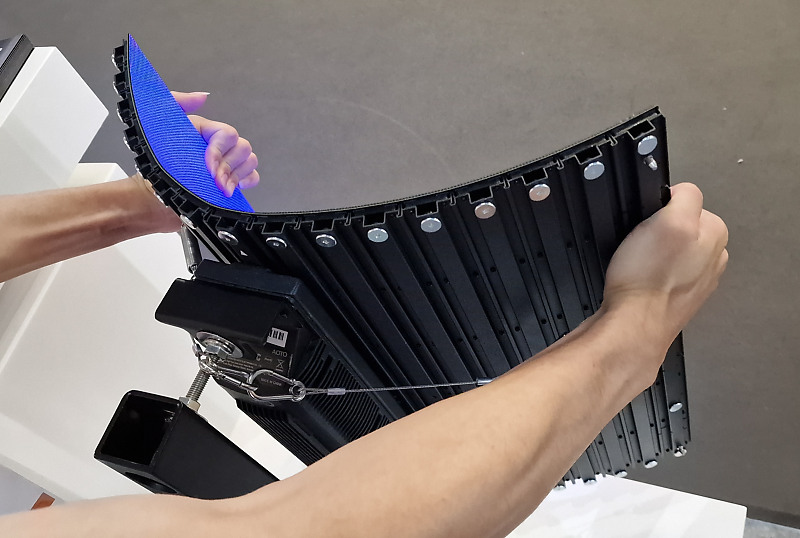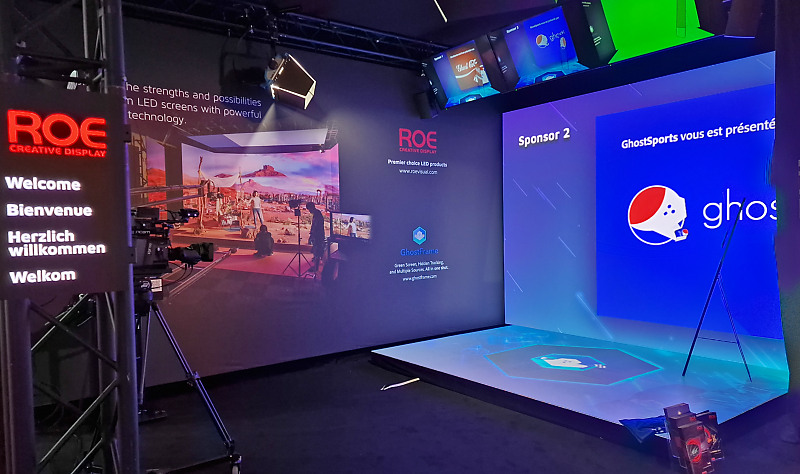There were many fewer LED makers at IBC this year, I thought, with a number of notable absentees. Those makers that were there (Absen, Aoto, Infiled and ROE) and were the main ones) were very much highlighting the use of their displays in virtual production systems. However, there was a distinct change in emphasis this year.

In previous years, the companies have just focused on their displays. However, this time, Absen and Infiled had changed their approach and were emphasising that they were able to supply complete systems with Brompton processors and integrated camera tracking systems. Clearly, these companies are invested in virtual production but it’s the first time I’ve been aware of them promoting complete solutions.
Infiled highlighted their genuinely curved displays. At the show, the firm had the inverse of what we typically see in curved monitors. Infiled was using some straight modules in the middle of their configuration with curved modules on the side. Modules are curved to 15 degrees using a special chassis. The company told us that 30 degree modules are also under development and small adjustments to the angle can be made on the edges of the chassis. The firm was demonstrating with technology from Ncam, Brompton and Disguise.
Absen was emphasising its Clear Cobalt COB LED technology which goes down currently to 0.9mm pitch. Staff told us that 0.7mm pitch is under development. As well as a Brompton processor, Absen told us that it is using media servers from Stype to drive the display. The main display was Absen’s AX technology which had 1.5mm pitch and uses 4-in-one SMD technology. The firm was also showing its 2.5mm floor display which was recently used in an XR stage in London. The staff described it as GOB or Glue on Board technology and said that the floor system could support 1000 kg/m2. Modules are 500 x 500mm.
Aoto was highlighting its curved option, but unlike the Infiled solution, the Aoto curved display is completely flexible and can be curved at any angle. Alternatively it can be fitted with a chassis to make a flat display and for fast installation. Th C Series is available in 1.875mm, 2.5mm and 3mm pitch with 1,000 cd/m2 of calibrated output and uses SMD LEDs. Contrast is quoted at 3,000:1 and the cabinet size is 480 x480 mm based on 240 x 480 modules. Nominal refresh rate is 3840Hz.
The firm also had its RM series product line which supports 1.56 ( 1,200 cd/m2) and 2.31mm pitch (1,500 cd/m2). The 2.31mm version is available in 6 scan and 18 scan versions and is aimed directly at Virtual Production. The LEDs are IMD-type with miniLEDs in a 4-in-1 configuration. Refresh rate is >=7680Hz.
Aoto said that it has done really well with XR studios and has around 30 installations in the US as well as very big XR studio for Tencent Studios in China.
ROE, which is the rental and staging division of Unilumin, was highlighting its support for the Ghostframe technology. This technology uses fast shutter speeds and refresh rates of the LEDs, in sync, to allow multiple different backgrounds to be recorded on a camera. This allows for the same live action to be recorded with different backgrounds to support different languages and designs.
Ghostframe was at the show for the first time under its own name. The company explained how some of its ‘special sauce’ is the way that it creates and displays ‘inverse’ images related to the extra frames. This gets the contrast back to nearer to the display if there was only one set of content. (this is needed because even though people can’t see the very fast extra frames, the light does get integrated in the eye and tends to reduce the contrast of the image if no compensation is applied).
Sony has a well developed virtual production system and uniquely (I think) covers all aspects of the system from the cameras to the Crystal LED display. Sadly our limited time at the event meant that we didn’t have time to talk to them properly – we’ll try to make up for that another time! (BR)



